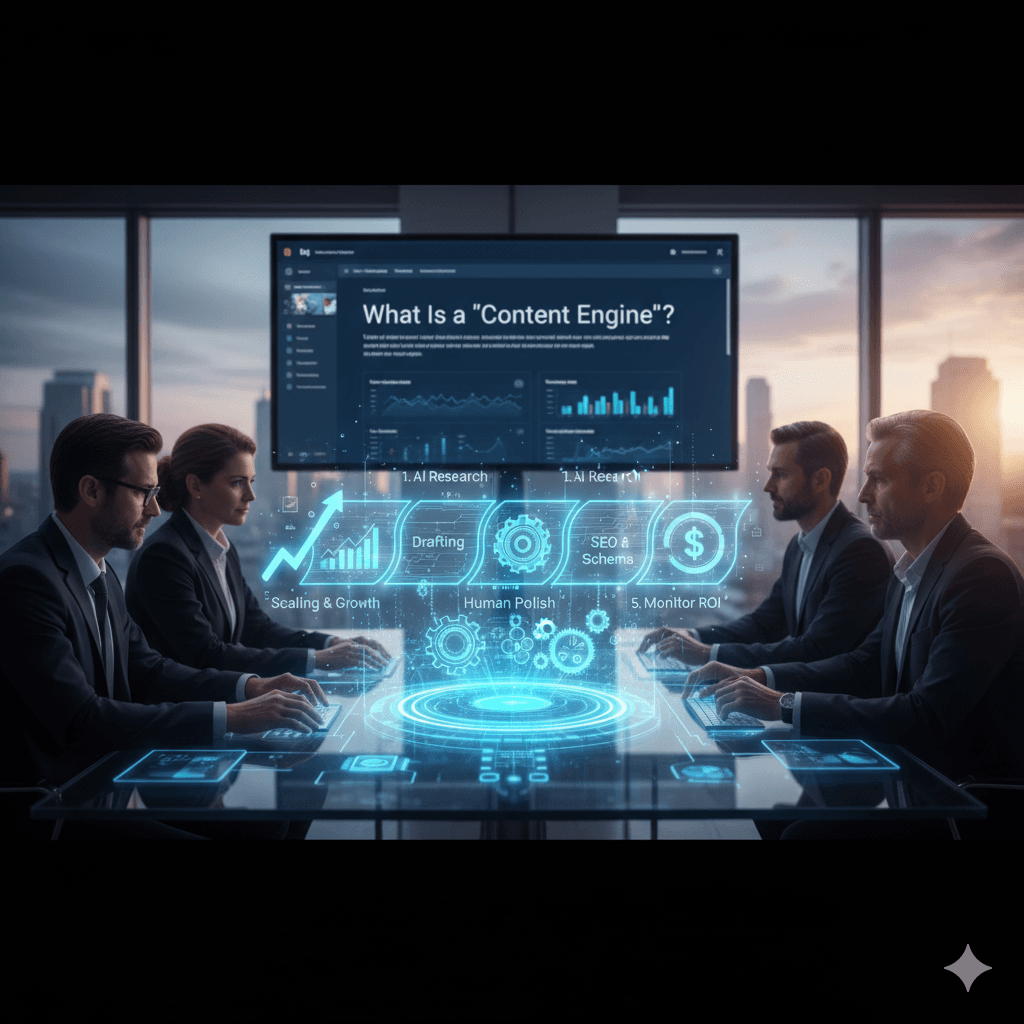What Is a 'Content Engine'? A 5-Step Guide to Scaling Your Blog for ROI

What Is a 'Content Engine'? A 5-Step Guide to Scaling Your Blog for ROI
Key Takeaway: A "Content Engine" is a strategic system that turns your blog from a simple publication into a predictable, AI-powered machine for generating leads and ROI. It involves 5 steps: AI-driven research, authoritative drafting, human-led polishing, technical optimization, and performance monitoring.
Let's be honest: "blogging" doesn't work.
You've spent months (or years) writing articles. You publish, you post to social media, and... nothing. You get a small spike in traffic, no leads, and no new business. You're stuck on a "content treadmill," burning resources with no measurable return.
The problem isn't your content. It's your process. You're treating your blog like a diary, not a strategic asset.
If you're stuck, you't need more articles. You need an engine. A content engine is a systematic process for creating and scaling content that is specifically designed to attract high-intent customers and drive revenue.
At Syntrax AI, we've perfected this process. Here is the 5-step guide to building one.
1. Step 1: AI-Driven Keyword & Topic Research
An engine starts with the right fuel. In content, that fuel is search intent.
Old Way: Guessing what topics "sound good" or writing about company news. This is the #1 cause of failure.
Engine Way: We use AI-powered tools to identify two types of keywords:
"Problem-Aware" Keywords: What your customers are searching for when they first realize they have a problem (e.g., "why is my blog not getting traffic").
"Solution-Aware" Keywords: What they search for when they are ready to buy (e.g., "best AI content agency").
This AI-driven research builds a strategic map. You're no longer guessing; you're systematically answering every question your ideal customer has.
2. Step 2: Authoritative Drafting
Once you have the topic, you must create the "best answer" on the internet.
This is where we leverage AI for efficiency. We use AI to generate a comprehensive first draft that covers all key entities, related questions, and structural elements for a topic. This "skeleton" draft ensures we are 10-foot-tall on the topic and have covered every angle.
But an AI draft is never the final product. It lacks the most important ingredient: your expertise.
3. Step 3: Human-Led Expert Polish
This is the most critical step and the one most companies skip. An AI-only article is generic, lacks a unique voice, and, most importantly, has no E-E-A-T (Experience, Expertise, Authoritativeness, Trustworthiness).
This is where human experts (like us) take over. We review the draft to:
Inject Your Voice: We rewrite the content to sound like your brand.
Add Real Experience: We add case studies, unique analogies, and first-hand stories that AI could never invent.
Fact-Check & Verify: We ensure every claim is accurate, current, and trustworthy.
This hybrid "AI-powered, human-led" approach gives you both scale and quality.
4. Step 4: Schema & AI-Readiness
An engine needs to be technically sound. In 2025, this means optimizing for other AIs.
Google's new Search Generative Experience (SGE) and other AI tools are now your primary audience. They need to crawl your content and understand it logically.
This is a technical step: We structure the content with clean headings (H1, H2, H3), bullet points, and short paragraphs.
We implement Schema Markup: We add code (like
ArticleandFAQPageschema) that explicitly tells Google, "This is an article," and "These are the key questions and answers."
This makes your content the perfect, citable source for AI overviews, giving you a massive advantage.
Find Your Website's Revenue Leaks
Our 5-minute AI Audit will find the most critical errors holding you back from more leads and sales.
Start Your Free AI Audit5. Step 5: Performance Monitoring & Iteration
A content engine is not "set it and forget it." It's a feedback loop.
The engine is only successful if it drives your business goals (leads, signups, demos). We use tools like Google Search Console and GA4 to track:
Which articles are bringing in traffic?
Which articles are converting that traffic into customers?
What new topics are your customers searching for?
We use this data to refine the keyword strategy (Step 1) and update old posts. The engine gets smarter and more efficient every month.
Stop Blogging, Start Building Your Engine
You can stop the guesswork. You can stop the "random acts of content" and the low-ROI burnout.
A content engine is the system that provides a predictable return. It's the asset that works for you 24/7, attracting qualified leads and building your authority, even when you're not writing.
If building and running this entire 5-step engine sounds like too much work, that's because it is. We can run it for you. This is the exact process we use for our "Content Engine" subscription.
See our monthly Content Engine product to have us build and run this system for you.
Frequently Asked Questions (FAQ)
1. What's the difference between a blog and a content engine? A blog is a publication, often driven by a calendar or random ideas. A content engine is a business system driven by data. Every article is a strategic asset created to acquire a specific type of customer and is measured by its ROI, not just its pageviews.
2. How long does it take for a content engine to get results? A content engine is a long-term strategy, not a short-term tactic. While technical fixes can improve things quickly, you should expect to see meaningful results in traffic and leads within 3-6 months as Google indexes your content and your authority grows.
3. Can AI replace the need for a content engine? No. AI is a tool within the engine (Steps 1 and 2), but it cannot replace the strategy. AI cannot identify your unique business goals, inject first-hand human experience (Step 3), or analyze performance data to make strategic pivots (Step 5).